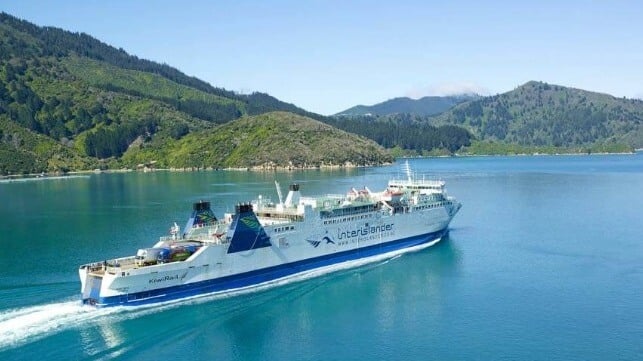New Zealand Looks to Future for Troubled Interisland Ferry Service

August has marked what many hope will be a turning point and the start of a new beginning for New Zealand’s KiwiRail and its troubled interisland ferry service. It reports that the previous iReX ferry program has been brought to a close with a final settlement with the shipyard, and this week it retired its oldest vessel as the first step in the modernization program.
The company provides a vital passenger and freight operation running RoRo ferries between the North and South islands. According to company data, each year it moves US$8.5 billion in freight, making more than 4,000 crossings. The company says it transports nearly 800,000 passengers and 250,000 cars annually on three vessels, the oldest of which was built in 1988, while the others were built in 1995 and 1998.
With government support, in 2020, it announced plans for two much larger ferries to enter service in 2025 and 2026. Each would have been 50,000 gross tons with a capacity for more than 1,900 passengers, versus the current ships, which have a maximum capacity of 650 passengers. They would also have accommodated 650 passenger cars versus the current 250. Contracts were signed in 2021 with Korea’s Hyundai Mipo Dockyard to build the vessels, which were to be hybrids with battery-electric power.
A new government elected in 2023 was critical of the project and reported it was canceling funding in part due to runaway cost estimates. KiwiRail terminated the order and began settlement negotiations with Hyundai Mipo. Last week, it was reported that a final settlement was completed at a cost of NZ$144 million (US$84.6 million). Along with a previous payment, KiwiRail reports the total cost was NZ$222 million (US$130 million) to Hyundai Mipo and an additional NZ$449 million (US$264 million), including costs of landside infrastructure.
“Doomsayers said cancelling the contract would cost the taxpayer the full NZ$551 million contract value, but these are some of the same people who accepted Project iReX ballooning from NZ$1.45 billion when approved in 2021 to Treasury warning it was on course to NZ$4 billion in 2023 thanks to eyes-bigger-than-their-mouths ambitions and absentee management,” said Ministers Nicola Willis (Finance) and Winston Peters (Foreign Affairs), in a joint statement on the settlement agreement.
They contend that there was not sufficient consideration given to the port infrastructure requirements for the two massive ferries. After winning the election, they allege they were confronted with “billion-dollar blowouts” due to the mismanagement by the prior government of the infrastructure projects.
“KiwiRail remains focused on working with Ferry Holdings Limited and the port companies to deliver two new rail-enabled ferries and the required infrastructure upgrades in Wellington and Picton by 2029. We’re looking forward to ensuring the safe and smooth transition of the new fleet into service for our people and customers when the time comes,” said Jason Dale, KiwiRail Chief Financial Officer.
The service has also experienced breakdowns, reports of poor maintenance, and management issues. In 2023 regulators said they would prosecute the company over maintenance issues which caused one of the vessels to black out during its crossing. In 2024, another one of the ferries went aground departing port with the investigation saying the crew did not know how to turn off the autopilot.
This week, the company began its plan by officially retiring the Aratere after its final sailing on August 18, a three-hour crossing between Picton and Wellington. The retirement of the vessel, which had been commissioned in 1999, is designed to permit the development of new port infrastructure. Aratere was the company’s only rail-enabled ferry, meaning freight cars were moved to the vessel and across the Cook Strait.
Aratere’s wharf in Picton is due to be demolished later this year as part of the new ferry project. Aratere required specialized wharf infrastructure to load and unload, including integrated rail tracks, so it cannot use Interislander’s other berths. Until the new ferries are delivered, freight will have to be transferred into trailers and trucks for the trip between the islands.
The ferry was laid up in Wellington with KiwiRail reporting it is considering options for its sale with a shipbroker. It says the plans for the new ferries are on schedule. Due for delivery by 2029, they will be larger, replacing all three current ships, and will reintroduce rail freight capabilities to the route.
